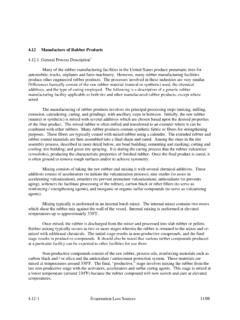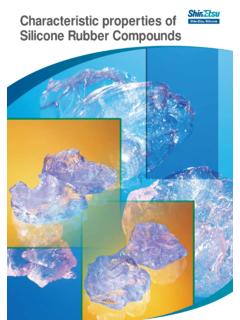Transcription of 11.25 Clay Processing - United States Environmental ...
1 clay Process Description1-4 clay is defined as a natural, earthy, fine-grained material, largely of a group of crystallinehydrous silicate minerals known as clay minerals. clay minerals are composed mainly of silica,alumina, and water, but they may also contain appreciable quantities of iron, alkalies, and alkalineearths. clay is formed by the mechanical and chemical breakdown of rocks. The six-digit SourceClassification Codes (SCC) for clay Processing are as follows: SCC 3-05-041 for kaolin Processing ,SCC 3-05-042 for ball clay Processing , SCC 3-05-043 for fire clay Processing , SCC 3-05-044 forbentonite Processing , SCC 3-05-045 for fuller s earth Processing , and SCC 3-05-046 for common clayand shale are categorized into six groups by the U.
2 S. Bureau Of Mines. The categories arekaolin, ball clay , fire clay , bentonite, fuller s earth, and common clay and shale. Kaolin, or china clay ,is defined as a white, claylike material composed mainly of kaolinite, which is a hydrated aluminumsilicate (Al2O3 2 SiO2 2H2O), and other kaolin-group minerals. Kaolin has a wide variety of industrialapplications including paper coating and filling, refractories, fiberglass and insulation, rubber , paint,ceramics, and chemicals. Ball clay is a plastic, white-firing clay that is composed primarily ofkaolinite and is used mainly for bonding in ceramic ware, primarily dinnerware, floor and wall tile,pottery, and sanitary ware. Fire clays are composed primarily of kaolinite, but also may containseveral other materials including diaspore, burley, burley-flint, ball clay , and bauxitic clay and of their ability to withstand temperatures of 1500 C (2700 F) or higher, fire clays generallyare used for refractories or to raise vitrification temperatures in heavy clay products.
3 Bentonite is aclay composed primarily of smectite minerals, usually montmorillonite, and is used largely in drillingmuds, in foundry sands, and in pelletizing taconite iron ores. Fuller s earth is defined as a nonplasticclay or claylike material that typically is high in magnesia and has specialized decolorizing andpurifying properties. Fuller s earth, which is very similar to bentonite, is used mainly as absorbents ofpet waste, oil, and grease. Common clay is defined as a plastic clay or claylike material with a vit-rification point below 1100 C (2000 F). Shale is a laminated sedimentary rock that is formed by theconsolidation of clay , mud, or silt. Common clay and shale are composed mainly of illite or chlorite,but also may contain kaolin and domestic clay is mined by open-pit methods using various types of equipment, includingdraglines, power shovels, front-end loaders, backhoes, scraper-loaders, and shale planers.
4 In addition,some kaolin is extracted by hydraulic mining and dredging. Most underground clay mines are locatedin Pennsylvania, Ohio, and West Virginia, where the clays are associated with coal deposits. A higherpercentage of fire clay is mined underground than other clays, because the higher quality fire claydeposits are found at depths that make open-pit mining less usually are transported by truck from the mine to the Processing plants, many of whichare located at or near the mine. For most applications, clays are processed by mechanical methods,such as crushing, grinding, and screening, that do not appreciably alter the chemical or mineralogicalproperties of the material. However, because clays are used in such a wide range of applications, it isoften necessary to use other mechanical and chemical processes, such as drying, calcining, bleaching,blunging, and extruding to prepare the material for Products crushing reduces material size from as much as one meter to a few centimeters indiameter and typically is accomplished using jaw or gyratory crushers.
5 Rotating pan crushers, conecrushers, smooth roll crushers, toothed roll crushers, and hammer mills are used for secondarycrushing, which further reduces particle size to 3 mm ( in.) or less. For some applications, tertiarysize reduction is necessary and is accomplished by means of ball, rod, or pebble mills, which are oftencombined with air separators. Screening typically is carried out by means of two or more multi-decksloping screens that are mechanically or electromagnetically vibrated. Pug mills are used for blunging,and rotary, fluid bed, and vibrating grate dryers are used for drying clay materials. At most plants thatcalcine clay , rotary or flash calciners are used. However, multiple hearth furnaces often are used tocalcine losses through basic mechanical Processing generally are insignificant.
6 However,material losses for processes such as washing and sizing can reach 30 to 40 percent. The mostsignificant Processing losses occur in the Processing of kaolin and fuller s earth. The followingparagraphs describe the steps used to process each of the six categories of clay . Table these processes by clay -Kaolin is both dry- and wet-processed. The dry process is simpler and produces a lowerquality product than the wet process. Dry-processed kaolin is used mainly in the rubber industry, andto a lesser extent, for paper filling and to produce fiberglass and sanitary ware. Wet-processed kaolinis used extensively in the paper manufacturing industry. A process flow diagram for kaolin miningand dry Processing is presented in Figure , and Figure illustrates the wet Processing the dry process, the raw material is crushed to the desired size, dried in rotary dryers,pulverized and air-floated to remove most of the coarse grit.
7 Wet Processing of kaolin begins withblunging to produce a slurry, which then is fractionated into coarse and fine fractions usingcentrifuges, hydrocyclones, or hydroseparators. At this step in the process, various chemical methods,such as bleaching, and physical and magnetic methods, may be used to refine the material. Chemicalprocessing includes leaching with sulfuric acid, followed by the addition of a strong reducing agentsuch as hydrosulfite. Before drying, the slurry is filtered and dewatered by means of a filter press,centrifuge, rotary vacuum filter, or tube filter. The filtered dewatered slurry material may be shippedor further processed by drying in apron, rotary, or spray dryers.
8 Following the drying step, the kaolinmay be calcined for use as filler or refractory material. Multiple hearth furnaces are most often usedto calcine kaolin. Flash and rotary calciners also are clay -Mined ball clay , which typically has a moisture content of approximately 28 percent, first isstored in drying sheds until the moisture content decreases to 20 to 24 percent. The clay then isshredded in a disintegrator into small pieces to centimeters (cm) ( to 1 in.) in shredded material then is either dried or ground in a hammer mill. Material exiting the hammermill is mixed with water and bulk loaded as a slurry for shipping. Figure depicts the processflow for ball clay rotary or vibrating grate dryers are used to dry ball clay .
9 Combustion gases from thefirebox pass through an air-to-air heat exchanger to heat the drying air to a temperature ofapproximately 300 C (570 F). The clay is dried to a moisture content of 8 to 10 percent. Followingdrying, the material is ground in a roller mill and shipped. The ground ball clay may also be mixedwith water as a slurry for bulk FACTORS1/95 Table clay Processing OPERATIONSP rocessKaolinBall ClayFire ClayBentoniteFuller sEarthCommonClay AndShaleMiningXXXXXXS tockpilingXXXXXXC rushingXXXXXXG rindingXXXXXXS creeningXXXXM ixingXXXB lungingXXXAir flotationXXSlurryingXXExtrudingXXDryingX XXXXC alciningXXPackagingXXXXXO therWaterfraction-ation,magneticseparati on,acidtreatment,bleachingShredding,pulv erizingWeathering,blendingCationexchange ,granulating,airclassifyingDispersingFir e clay -Figure illustrates the process flow for fire clay Processing .
10 Mined fire clay first istransported to the Processing plant and stockpiled. In some cases, the crude clay is weathered for 6 to12 months, depending on the type of fire clay . Freezing and thawing break the material up, resultingin smaller particles and improved plasticity. The material then is crushed and ground. At this stage inthe process, the clay has a moisture content of 10 to 15 percent. For certain applications, the clay isdried in mechanical dryers to reduce the moisture content of the material to 7 percent or , rotary and vibrating grate dryers fired with natural gas or fuel oil are used for drying increase the refractoriness of the material, fire clay often is calcined. Calcining eliminatesmoisture and organic material and causes a chemical reaction to occur between the alumina and silicain the clay , rendering a material (mullite) that is harder, denser, and more easily crushed than1/95 Mineral Products Process flow diagram for kaolin mining and dry Processing .
















